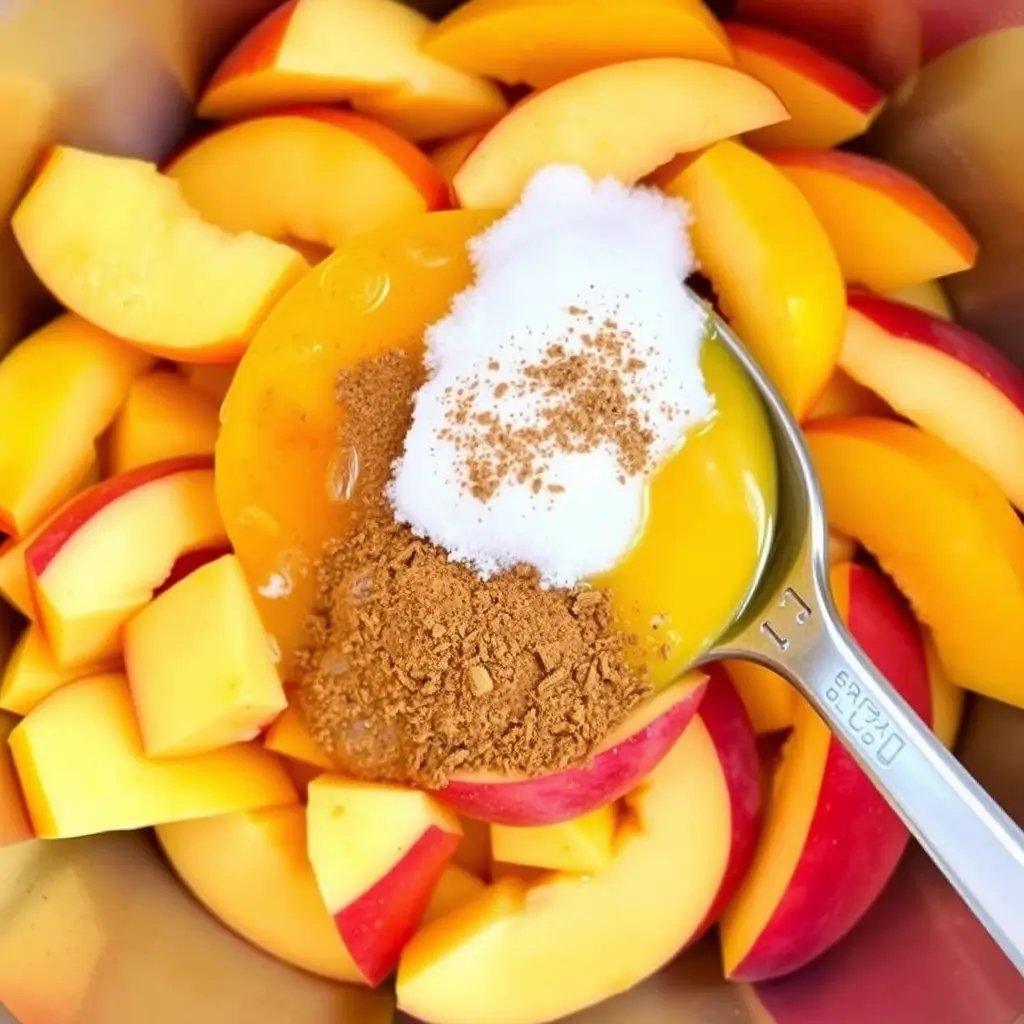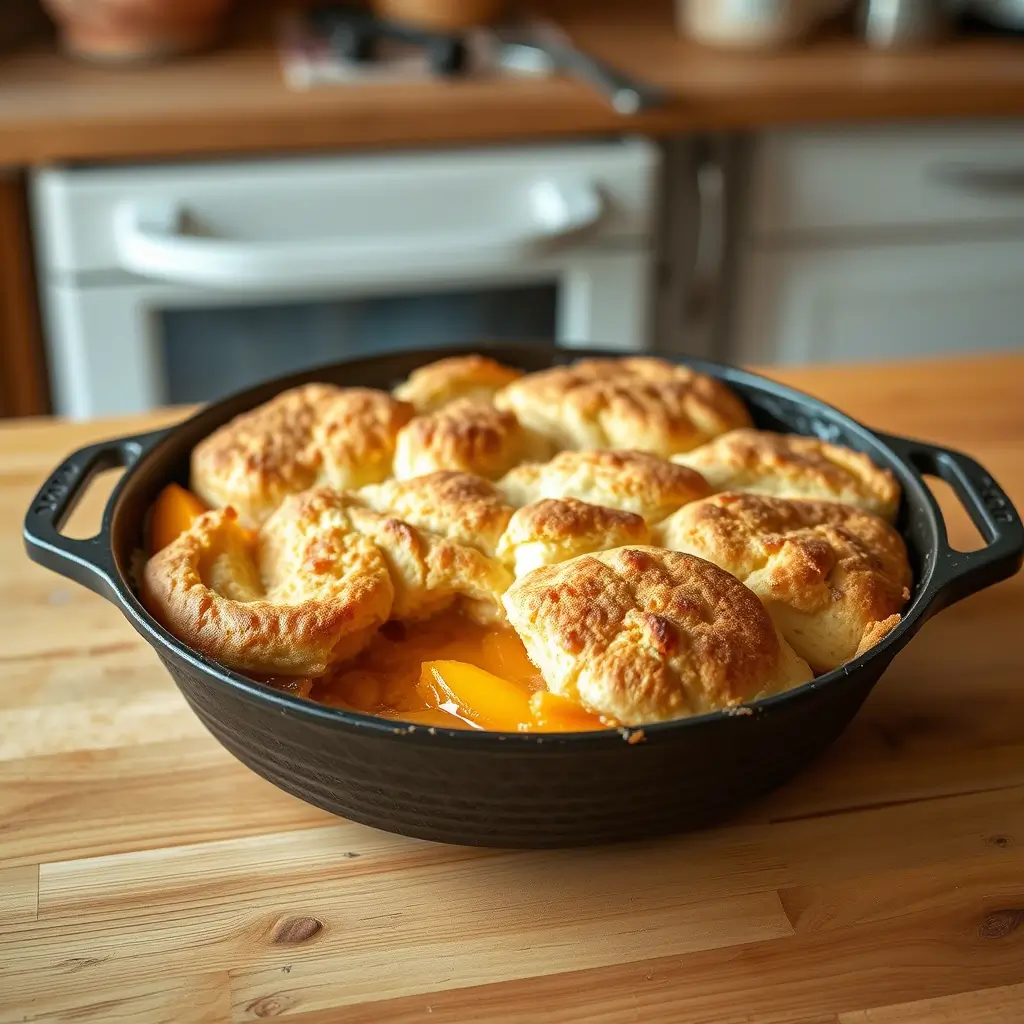
| The Ultimate Peach Cobbler Recipe – Easy, Old-Fashioned & Delicious There’s nothing quite like a warm, homemade peach cobbler fresh out of the oven. With its juicy, sweet peach filling and golden, buttery crust, this Southern classic is a must-try dessert, especially during peach season. Whether you’re looking for an easy peach cobbler recipe or a traditional old-fashioned version, you’re in the right place! In this ultimate guide, we’ll cover everything you need to know about making the best peach cobbler. You’ll learn: ✅ The history and origins of peach cobbler ✅ The best ingredients to use, including fresh, canned, or frozen peaches ✅ Step-by-step baking instructions for a perfect cobbler ✅ Expert tips to avoid common baking mistakes ✅ Fun variations, including gluten-free, vegan, and berry-infused cobblers ✅ How to store and reheat leftovers for a fresh-baked taste Ready to bake? Let’s start by learning what makes this dessert so special! |
Table of Contents
Part 1: Introduction to Peach Cobbler (250 words)
What is Peach Cobbler?
Peach cobbler is a classic Southern dessert made with a sweet, juicy peach filling and a biscuit-like or cake-like crust. Unlike a traditional pie, cobbler doesn’t have a bottom crust—instead, the dough is dropped or spread over the fruit before baking. The result? A crispy, golden topping with bubbling peaches underneath!
This dish is perfect for summer gatherings, potlucks, and cozy family dinners. Serve it warm with a scoop of vanilla ice cream or whipped cream, and you’ve got a dessert that’s hard to resist.
A Brief History of Peach Cobbler
The origins of peach cobbler date back to early American settlers who lacked the proper ingredients and equipment to make pies. Instead of a traditional pastry crust, they baked sweetened fruit with a biscuit-like topping in cast-iron skillets over an open fire.
Over time, this easy peach dessert became a Southern staple, evolving into different variations. Some prefer a flaky pie-like crust, while others love a soft, cake-like cobbler topping. No matter the method, homemade peach cobbler remains one of the best fruit desserts of all time!
Why You’ll Love This Peach Cobbler Recipe
This old-fashioned peach cobbler recipe is:
✔ Simple & Quick – No complicated techniques, just a few easy steps!
✔ Versatile – Use fresh, canned, or frozen peaches year-round.
✔ Perfectly Balanced – The right mix of sweetness, tartness, and buttery goodness.
✔ Great for Any Occasion – Whether it’s a summer picnic or a cozy winter treat, peach cobbler is always a hit!
Now that you know the basics, let’s dive into the best ingredients for making the perfect peach cobbler! 🍑
Part 2: Essential Ingredients for the Best Peach Cobbler (300 words)
Fresh vs. Canned vs. Frozen Peaches – Which to Use?
One of the most important choices when making a peach cobbler is deciding between fresh, canned, or frozen peaches. Each option has its benefits:
- Fresh peaches are ideal when they’re in season. They provide the best flavor, natural sweetness, and a slight tartness that balances the dessert.
- Canned peaches work year-round and are already sweetened. If using canned peaches, opt for those in juice rather than syrup to avoid excess sweetness.
- Frozen peaches are a great alternative if fresh peaches aren’t available. Just be sure to thaw and drain them well to prevent a watery cobbler.
Key Ingredients for a Perfect Cobbler Crust

A great peach cobbler has a crispy yet tender crust. Here’s what you’ll need:
- Flour – All-purpose flour provides structure and texture.
- Sugar – A mix of white and brown sugar enhances sweetness and caramelization.
- Baking powder – Helps the dough rise and stay light.
- Butter – Adds richness and creates a flaky texture.
- Milk or buttermilk – Ensures a soft and tender crust.
Sweeteners: White Sugar vs. Brown Sugar vs. Honey
Choosing the right sweetener can enhance the flavor of your peach cobbler:
- White sugar keeps the flavor light and sweet.
- Brown sugar adds depth and a hint of caramel due to its molasses content.
- Honey brings a natural, floral sweetness and pairs well with cinnamon and nutmeg.
Flavor Enhancers: Cinnamon, Nutmeg, and Vanilla Extract
Spices make a huge difference in a peach cobbler recipe. A dash of cinnamon and nutmeg adds warmth, while vanilla extract enhances the natural sweetness of the peaches. For a citrusy twist, try lemon zest!
Now that you’ve got your ingredients ready, let’s go step by step on how to make the perfect cobbler!
Part 3: Step-by-Step Guide – How to Make Peach Cobbler (400 words)

Prepping the Peaches – Peeling, Slicing & Sweetening
To get the best results, follow these steps when preparing fresh peaches:
- Peel the peaches – The easiest way is to blanch them in boiling water for 30 seconds, then transfer them to an ice bath. The skins will slide right off!
- Slice evenly – Cut peaches into ½-inch thick slices for even baking.
- Sweeten & season – Toss the peaches with sugar, cinnamon, nutmeg, and a splash of lemon juice to balance flavors.
If using canned or frozen peaches, drain them well to prevent excess liquid in the cobbler.
Making the Cobbler Crust – Biscuit vs. Cake-Like Topping
There are two main types of peach cobbler crusts:
✔ Biscuit-style topping – This uses a buttery dough that creates a crisp, golden crust. Perfect for those who love a traditional cobbler with a bit of crunch.
✔ Cake-like topping – A batter-based topping that bakes into a soft, fluffy texture. This is great if you prefer a lighter cobbler.
Layering and Assembling for Perfect Texture
The layering process is key to getting the right texture in your cobbler:
- Melt butter in a baking dish to create a rich base.
- Pour the batter or drop biscuit dough over the butter—don’t mix!
- Spoon the peaches and their juices over the batter. As it bakes, the batter will rise through the fruit, creating the classic cobbler look!
Baking Tips – Temperature, Time & Achieving a Golden-Brown Finish
Bake your peach cobbler at 375°F (190°C) for 40-45 minutes until:
✅ The top is golden brown and crisp.
✅ The peach filling is bubbling around the edges.
✅ A toothpick inserted into the crust comes out clean.
For a caramelized finish, sprinkle a little extra sugar on top before baking.
For another delicious take on this classic dessert, check out this peach cobbler recipe on AfricanoRecipes!
Part 4: Tips & Tricks for the Best Peach Cobbler (350 words)
How to Prevent a Soggy Cobbler
One of the most common issues with peach cobbler is ending up with a soggy texture. To keep your cobbler perfectly crisp:
- Drain excess liquid – If using canned or frozen peaches, be sure to drain them well. Too much juice can make the filling watery.
- Toss peaches with cornstarch – A tablespoon of cornstarch or flour will help thicken the filling as it bakes.
- Preheat the oven properly – A hot oven ensures that the crust bakes evenly and doesn’t turn mushy.
- Avoid overloading with peaches – Too many peaches can create too much moisture, making the crust soft rather than crisp.
Getting the Perfect Crisp, Golden Crust
The best peach cobbler has a perfectly crisp, golden-brown topping. To achieve this:
- Brush the crust with melted butter before baking for a richer flavor.
- Sprinkle sugar on top for a slight caramelized crunch.
- Bake uncovered for the last 10 minutes to crisp up the top.
Using Cornstarch to Thicken the Peach Filling
Nobody likes a runny cobbler! Adding cornstarch to your peach mixture helps thicken the juices, creating a rich, syrupy consistency instead of a soupy mess. If you don’t have cornstarch, all-purpose flour or tapioca starch are great alternatives.
Serving Suggestions – Ice Cream, Whipped Cream & More
Peach cobbler is best served warm, but what you pair it with can elevate the experience:
- Vanilla ice cream – The cold, creamy texture balances the warm cobbler perfectly.
- Whipped cream – Adds a light and airy contrast.
- Caramel drizzle – A touch of caramel sauce can enhance the sweetness of the peaches.
- Chopped nuts – Sprinkle chopped pecans or almonds for a crunchy twist.
With these tips, your peach cobbler will turn out perfectly every time! Now, let’s go over some common mistakes and how to fix them.
Part 5: Common Mistakes & How to Avoid Them (250 words)
Overly Sweet or Bland Filling – How to Balance Flavors
Getting the right sweetness level in your peach cobbler is key. Here’s how to find the perfect balance:
- Use ripe peaches – Fresh, in-season peaches are naturally sweet, so you won’t need as much added sugar.
- Adjust sugar based on peaches – If your peaches are very sweet, reduce the sugar. If they’re tart, add a little more.
- Add lemon juice – A splash of lemon juice enhances the flavor and keeps the sweetness from being overwhelming.
Runny vs. Dry Cobbler – Finding the Right Consistency
If your cobbler is too runny, it likely has too much liquid. Thicken the filling with cornstarch before baking, and make sure to bake it long enough for the juices to set.
If your cobbler is too dry, the peaches might have lacked natural juice. Try adding a bit of extra peach syrup, orange juice, or a touch of butter to bring moisture back.
Overbaking or Undercooking – Achieving the Perfect Bake
- Undercooked cobbler will have a doughy, raw-tasting crust. Bake until the top is golden brown and the filling is bubbling.
- Overbaked cobbler can turn dry. To prevent this, cover loosely with foil if it starts browning too quickly.
Choosing the Right Pan for Even Baking
The type of baking dish can impact your results:
- Glass or ceramic dishes bake more evenly but take longer to heat.
- Metal pans heat faster and create a crispier crust.
- Cast-iron skillets add a rustic touch and bake cobbler beautifully.
For another delicious cobbler variation, check out this peach cobbler recipe on AfricanoRecipes!
Part 6: Variations & Customizations (300 words)
Southern-Style Peach Cobbler vs. Classic Peach Cobbler
Peach cobbler comes in different styles, but the Southern version stands out. Traditional Southern-style peach cobbler has a rich, buttery crust that resembles a pie topping, while classic peach cobbler often features a biscuit or cake-like topping.
- Southern-style cobbler uses a lattice crust or drop biscuit dough, giving it a crispy and flaky texture.
- Classic cobbler has a batter-based crust that creates a soft, cake-like consistency when baked.
Both versions are delicious, so it all depends on personal preference!
Gluten-Free Peach Cobbler – Best Flour Substitutes
Want a gluten-free peach cobbler? No problem! Swap all-purpose flour with these alternatives:
✔ Almond flour – Adds a slightly nutty flavor and a tender texture.
✔ Oat flour – Naturally gluten-free and gives a soft, crumbly crust.
✔ Gluten-free all-purpose flour – A 1:1 blend works well as a direct substitute.
To ensure your gluten-free cobbler binds properly, add an extra egg or a teaspoon of xanthan gum to mimic the elasticity of wheat flour.
Vegan & Dairy-Free Peach Cobbler Options
You can easily make a vegan peach cobbler by replacing dairy and eggs with plant-based alternatives:
✔ Use coconut oil or vegan butter instead of regular butter.
✔ Swap milk with almond, oat, or coconut milk for a creamy texture.
✔ Use flax eggs (1 tbsp flaxseed + 3 tbsp water per egg) instead of regular eggs.
Adding Other Fruits – Blueberries, Blackberries & More
Want to add a twist to your peach cobbler? Mix in other fruits for a burst of flavor:
✔ Blueberry Peach Cobbler – The perfect balance of sweet and tart.
✔ Blackberry Peach Cobbler – Adds depth and richness to the filling.
✔ Strawberry Peach Cobbler – A summer favorite with a light, fruity touch.
Now that we’ve explored creative variations, let’s talk about how to store and reheat your cobbler so it stays delicious!
Part 7: Storing & Reheating Peach Cobbler (250 words)
Best Ways to Store Leftover Peach Cobbler
If you have leftovers (which isn’t always the case because it’s that good!), here’s how to store your peach cobbler properly:
- At room temperature: Keep it loosely covered for up to 24 hours.
- In the fridge: Store in an airtight container for up to 4 days.
- Separate the crust from the filling: If you want to keep it extra crisp, store the crust separately and reassemble before reheating.
How to Reheat for a Freshly Baked Taste
Reheating cobbler the right way ensures it tastes just as fresh as when you first made it:
- Oven (Best method): Bake at 350°F (175°C) for 10-15 minutes to crisp up the crust.
- Air Fryer: Heat at 325°F (163°C) for 5-7 minutes for a quick crisp.
- Microwave (Fastest): Heat in 20-second intervals until warm. The crust won’t be as crisp, but the flavors will still shine!
Can You Freeze Peach Cobbler?
Yes! Freezing is a great way to save cobbler for later:
- Let it cool completely.
- Wrap it tightly in plastic wrap and foil.
- Freeze for up to 3 months.
- Reheat directly from frozen in the oven at 350°F (175°C) for 30-40 minutes.
With these storage and reheating tips, you can enjoy homemade peach cobbler anytime!
Part 8: Frequently Asked Questions (FAQs) (200 words)
Can I make peach cobbler ahead of time?
Yes! You can prepare peach cobbler in advance to save time. If making it a day ahead, assemble the cobbler but don’t bake it. Cover and store it in the fridge, then bake fresh when needed. If it’s already baked, just reheat in the oven at 350°F (175°C) for 10-15 minutes before serving.
How do I keep my cobbler from becoming too runny?
A runny peach cobbler usually happens when there’s too much liquid. To fix this:
- Add cornstarch to the peach filling to thicken the juices.
- Drain canned or frozen peaches well before using them.
- Bake until bubbly—this helps the filling set properly.
Can I use store-bought pie crust instead of homemade?
Yes! While traditional peach cobbler uses a biscuit or cake-like topping, you can use a store-bought pie crust for convenience. Simply layer it over the peaches and bake until golden brown.
What’s the difference between peach cobbler and peach crisp?
Both are delicious, but they have key differences:
- Peach cobbler has a soft, biscuit-like or cake-like crust.
- Peach crisp has a crispy topping made with oats, sugar, and butter.
Now that we’ve covered common questions, let’s dive into the nutritional breakdown of this delicious dessert!
Part 9: Nutritional Information (Per 100g) (200 words)
Nutritional Breakdown (Per 100g Serving)
htmlCopierModifier<table border="1" cellpadding="8" cellspacing="0">
<tr>
<th>Nutrient</th>
<th>Amount</th>
</tr>
<tr>
<td>Calories</td>
<td>210 kcal</td>
</tr>
<tr>
<td>Carbohydrates</td>
<td>35g</td>
</tr>
<tr>
<td>Sugar</td>
<td>20g</td>
</tr>
<tr>
<td>Protein</td>
<td>2g</td>
</tr>
<tr>
<td>Fat</td>
<td>7g</td>
</tr>
<tr>
<td>Saturated Fat</td>
<td>3g</td>
</tr>
<tr>
<td>Fiber</td>
<td>2g</td>
</tr>
<tr>
<td>Sodium</td>
<td>180mg</td>
</tr>
</table>
Understanding the Nutritional Breakdown
- Calories – A serving of peach cobbler is moderately high in calories due to its sugar and butter content.
- Carbohydrates & Sugar – The peaches and added sugar contribute to the sweet, rich taste.
- Protein – Minimal, but can be increased by adding nuts or serving with Greek yogurt.
- Fats – Mostly from butter, which gives the cobbler its flaky crust.
- Fiber – Fresh peaches add natural fiber, which helps digestion.
For a healthier version, try reducing the sugar, using whole wheat flour, or adding oats for extra fiber.
